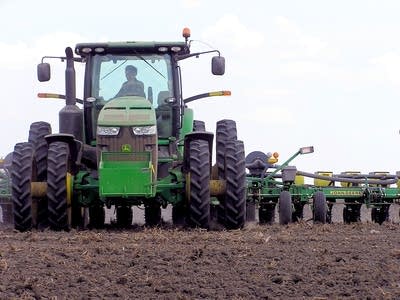Food stamps, crop insurance big issues in new farm bill
Go Deeper.
Create an account or log in to save stories.
Like this?
Thanks for liking this story! We have added it to a list of your favorite stories.

This week, both the House and Senate Agriculture Committees are debating a new farm bill. The current legislation directed more than $1 billion to Minnesota last year in the form of food stamp benefits and subsidized crop insurance for farmers.
Those two expensive programs are the most controversial portions of the new bill Congress is considering.
The Democratic-controlled Senate passed its bill 11 months ago, but the House never voted on its version. Both farm bills are mostly similar to the bills put forward last year.
Democratic Sen. Amy Klobuchar referred to last year's experience when the Senate Agriculture Committee met on Tuesday.
Turn Up Your Support
MPR News helps you turn down the noise and build shared understanding. Turn up your support for this public resource and keep trusted journalism accessible to all.
"We look forward to getting this bill to the floor and not having another 327 days pass," Klobuchar said.
GOP leaders kept the House from voting on last year's committee-approved bill because of election year disagreements over how much to cut from the food stamp program.
That decision angered Minnesota's 7th District Rep. Collin Peterson, who is the ranking Democrat on the agriculture committee and a former chairman.
This time around, Peterson said both House Speaker John Boehner and Majority Leader Eric Cantor have given their support to the bill.
"From everything I can tell, this is on track to move to the floor in June," Peterson said.
Once again, the food stamp program is a source of conflict.
That program gave more than 500,000 Minnesotans in poverty an average of $115 a month last year for groceries, according to the Department of Agriculture.
The measure approved Tuesday by the Senate Agriculture Committee makes relatively small cuts of about $400 million a year out of $80 billion in annual spending.
The House farm bill, which Peterson co-authored with the Republican chair, Rep. Frank Lucas of Oklahoma, cuts $2 billion a year, or five times as much as the Senate bill.
Many liberal Democrats think those cuts go too far, but Peterson disagrees.
"What we're talking about is a 2.5 percent reduction," he said.
Many House Republicans would like even larger cuts to food stamps.
Long-time Farm Bureau lobbyist Mary Kay Thatcher said the philosophical disagreement between Democrats and Republicans on food stamps is so large that the House and Senate may struggle to agree on how much to cut when lawmakers have to negotiate a compromise bill.
"Just picking a number and saying it will be 10 or 15 (billion) or it will be 40 (billion) is really hard to do," Thatcher said.
Moreover, analyst Stacy Dean at the liberal Center for Budget and Policy Priorities questions why lawmakers are cutting food stamps at all.
"Poverty and unemployment remain incredibly high in this country. We have food banks with lines going out the door," Dean said.
The bills also revamp farm subsidies and end the direct payment system that sent cash to farmers. Instead, both measures make the federally subsidized crop insurance system more generous. The federal government subsidizes more than 60 percent of the premium farmers pay for crop insurance.
In 2011, Minnesota farmers bought more than 131,000 policies at a cost of $525 million to taxpayers, according to data from the nonprofit Environmental Working Group.
Bruce Babcock, an economics professor at Iowa State University and regular critic of crop subsidies, said one of the new crop insurance proposals in the Senate bill is particularly generous to farmers.
"Those of us who have automobile insurance with a $500 deductible, it would be the same as if we were being given insurance for that deductible," Babcock said.
In other words, farmers would barely be on the hook for any losses they suffer, he said. Farmers say crop insurance enabled them to survive hard times, such as last summer's drought, without a government bailout.
But the government's support for crop insurance has taken all of the risk out of farming and is responsible for the real estate boom in farm country, Babcock said.
"The more subsidies and the more crop insurance we enable farmers to buy, the more they bid up the price of land," he said.
But right now, there appears to be little interest in taking on the crop insurance programs in either the House or Senate farm bills, although some lawmakers are sure to try to make changes during the floor debates.
Lawmakers hope to get a completed farm bill to President Barack Obama's desk by the beginning of August.




